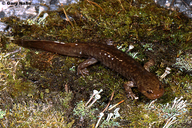|
Dicamptodon aterrimus (Cope, 1868)
Idaho Giant Salamander | family: Dicamptodontidae genus: Dicamptodon |
 © 2004 Gary Nafis (1 of 7) |
|
|
|
Description Distribution and Habitat Country distribution from AmphibiaWeb's database: United States U.S. state distribution from AmphibiaWeb's database: Idaho, Montana
Life History, Abundance, Activity, and Special Behaviors One female laid 185 eggs (in captivity) during the fall. She was captured 2 feet deep in a rock pile, a likely nest site (Nussbaum 1969). This species is facultatively paedomorphic; populations may include both gilled, fully aquatic adults as well as terrestrial metamorphic adults (Sepulveda and Lowe 2009). Larva The diet of larval Idaho giant salamanders includes a variety of invertebrates and the larvae of tailed frogs (Ascaphus) (Metter 1963). Trends and Threats Populations appear to be stable in undisturbed areas. Threats include habitat loss and degradation resulting from logging, the building of roads, and siltation of streams. This species is able to recolonize formerly disturbed areas once they have been restored. It occurs in several areas that are designated wilderness (Hammerson 2004; Sepulveda and Lowe 2009). Comments The genus Dicamptodon was historically included as a subfamily (Dicamptodontinae) in the family Ambystomatidae, and was placed in a separate family, Dicamptodontidae, based on features of the spinal nerves (Edwards 1976).
References
Bury, R. B., Corn, F. S., Aubry, K. B., Gilbert, F. F., and Jones, L. L. C. (1991). ''Aquatic amphibian communities in Oregon and Washington.'' Wildlife and Vegetation of Unmanaged Douglas-fir Forests. K. Ruggiero, B. Aubry, A. B. Carey, and M. H. Huff, eds., USDA Forest Service General Technical Report PNW-GTR-285, 353-362. Daugherty, C. H., Allendorf, F. W., Dunlap, W. W., and Knudsen, K. L. (1983). ''Systematic implications of geographic patterns of genetic variation in the genus Dicamptodon.'' Copeia, 1983(3), 679-691. Edwards, J.L. (1976). "Spinal nerves and their bearing on salamander phylogeny." Journal of Morphology, 148, 305-328. Good, D.A. (1989). "Hybridization and cryptic species in Dicamptodon (Caudata: Dicamptodontidae)." Evolution, 43, 728-744. Hammerson, G. 2004. Dicamptodon aterrimus. In: IUCN 2010. IUCN Red List of Threatened Species. Version 2010.4. Metter, D. (1963). "Stomach contents of Idaho larval Dicamptodon." Copeia, 1963, 435-436.
Nussbaum, R. A. (1969). ''Nests and eggs of the Pacific Giant Salamander, Dicamptodon ensatus (Eschscholtz).'' Herpetologica, 25, 257-262.
Nussbaum, R. A. (1976). "Geographic variation and systematics of salamanders of the genus Dicamptodon Strauch (Ambystomatidae)." Miscellaneous Publications of the Museum of Zoology, University of Michigan, 149, 1-94.
Petranka, J. W. (1998). Salamanders of the United States and Canada. Smithsonian Institution Press, Washington D.C. and London.
Roni, P. (2002). ''Habitat use by fishes and Pacific Giant Salamanders in small western Oregon and Washington streams.'' Transactions of the American Fisheries Society, 131, 743-761.
Sepulveda, A. J., and Lowe, W. H. (2009). ''Local and landscape-scale influences on the occurrence and density of Dicamptodon aterrimus, the Idaho Giant Salamander.'' Journal of Herpetology, 43, 469-484.
Stebbins, R. C. (1985). A Field Guide to Western Reptiles and Amphibians. Houghton Mifflin, Boston.
Species Account Citation: AmphibiaWeb 2022 Dicamptodon aterrimus: Idaho Giant Salamander <https://amphibiaweb.org/species/3864> University of California, Berkeley, CA, USA. Accessed Nov 12, 2024.
Citation: AmphibiaWeb. 2024. <https://amphibiaweb.org> University of California, Berkeley, CA, USA. Accessed 12 Nov 2024.
AmphibiaWeb's policy on data use.
|




 Raffaëlli Account
Raffaëlli Account Map of Life
Map of Life